Author's posts
Dec 20 2022
Update on vSphere version adoption
I recently published some metrics on which version of vSphere customers were running which highlighted that a large percentage of customers were still on vSphere 6.x. That was right around the time that vSphere 6.7 went end of support so I wanted to check again to see if there were more customers on 7.x.
Here’s that latest stats from the end of December which is more than 2 months after vSphere 6.7 went end of support and vSphere 8.0 was released.
December 2022
| vCenter version | # | % |
| 7.0.3 | 7,285 | 61.2 |
| 6.7 | 3,002 | 25.5 |
| 6.5 | 616 | 5.2 |
| 7.0.2 | 566 | 4.8 |
| 7.0.1 | 97 | .8 |
| 8.0 | 83 | .7 |
| 6.0 | 66 | .6 |
| 7.0 | 44 | .4 |
| 5.5 | 35 | .3 |
| ESXi version | # | % |
| 7.0.3 | 41,462 | 51.8 |
| 6.7 | 21,896 | 27.4 |
| 6.5 | 8,422 | 10.5 |
| 7.0.2 | 4,950 | 6.2 |
| 7.0.1 | 1,615 | 2.0 |
| 6.0 | 1,113 | 1.4 |
| 5.5 | 292 | .4 |
| 7.0 | 193 | .2 |
| 8.0 | 98 | .1 |
I’ve summarized the changes in the below table:
| vCenter 6.x | vCenter 7.x | ESXi 6.x | ESXi 7.x | |
| April 2022 | 56% | 44% | 67% | 33% |
| October 2022 | 41% | 59% | 52% | 48% |
| December 2022 | 31% | 68% | 39% | 60% |
So we can see there are still a lot of customers on 6.x but about 2/3 are now on 7.x with 7.0.3 being the most popular version. Not a lot of customers are looking at 8.x yet which will probably start increasing after 8.0 U1 is released but if past history is an indicator it will be years before 8.x is mainstream.
Oct 24 2022
The Past, Present and Future of VASA and VMware vVols
VMware Virtual Volumes has been in development for quite a long time, almost 10 years now if you count the development before it launched as part of vSphere 6.0. I personally have been involved with it from a partner perspective for that long so I have had a behind the scenes view of how it has evolved.
So let’s start at the beginning, before there was vVols, there was VASA, the vStorage APIs for Storage Awareness. VASA was introduced as part of vSphere 5.0 as a way for storage arrays to pass information to vCenter about array hardware and software features. Prior to VASA vCenter just saw a LUN that was presented to it and no information about it was available, was it a spinning disk or SSD, what Raid level did it have, was it thin or not, etc.
So VASA 1.0 was introduces as a way for storage arrays to pass a string on information to vCenter that described the LUN’s characteristics. Armed with that knowledge you could then build storage profiles using those characteristics and assign them to VMs based on requirements and SLA’s. The initial release of VASA was very basic, the array had to provide a single string to vCenter that had the capabilities of the LUN together inside of it, so something like: “HPE_STORAGE, DriveType_FC, RAID5, ThinProvisioned, PhysicalCopy, NotInRemoteCopy” was passed to vCenter.
Below is a clip from the original VASA 1.0 Programming Guide describing it:

The original VASA 1.0 was not used by many as it was pretty basic but it was a step in the right direction, VMware took that VASA framework and greatly expanded it to create Virtual Volumes. While Virtual Volumes launched as part of vSphere 6.0 in 2015, it actually was announced at VMworld 2013 as part of their storage announcement keynote.
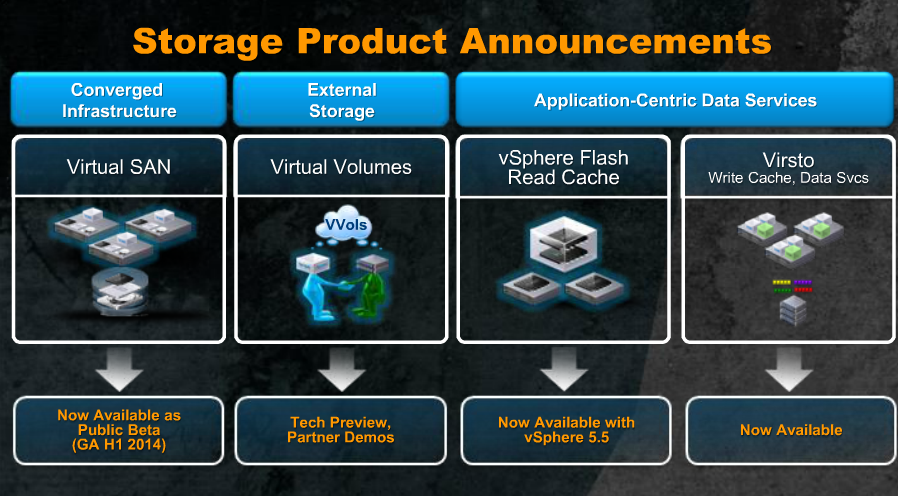
Virtual Volumes then launched as part of vSphere 6.0 with great fanfare, I remember working closely with VMware on a whole slew of deliverables to support the launch. Not many vendors supported it at launch, at that point it had been in development for almost 5 years and only 4 vendors supported it on day 0 (HP, IBM, NEC and SANBlaze).
The initial reaction to vVols was lukewarm, there was a lot of interest but not many vendors supported it and there were many limitations back then. One of the key limitations was that it did not support array based replication. That was then fixed by the release of vSphere 6.5 which included support for replication, but only HP supported it at launch and it would be many years before more vendors supported it.
After that it was relatively quiet for a long period of time, there was a minor spec increment (VASA 3.5) as part of vSphere 7.0 U1 but many partners were still trying to develop their support for vVols so VMware was holding off adding more big features to the roadmap until more partners caught up.
That brings us to the present and the launch of vSphere 8.0 which includes the VASA 4.0 specification which adds support for NVMeoF to vVols. Initially this support is for FC only but VMware plans to release additional protocol support as part of updates to vSphere 8.0.
Looking to the future, VMware has a VASA 5.0 program in the works which greatly improves the certificate framework that vVols uses between the host, vCenter and storage arrays. After that comes the long awaited support for stretched clustering as part of VASA 6.0. This has been a key one that many customers are waiting for before they will consider using vVols.
VASA 6.0 is a huge engineering effort both by VMware and it’s partners to deliver the same stretched storage architecture that is used with VMFS in a vMSC config. Before VASA 6.0 existed we looked into how we could support this using the current VASA 3.x spec and it was very complicated and a massive amount of work to pull it off.
VMware recognized the need to support this and proceeded to modify the spec to support new objects like stretched storage containers and stretched vVols across various host connectivity configurations. Thus VASA 6.0 was born which created the framework to support stretched clustering and made it easier for storage vendors to develop their own implementations.
Below is the complete timeline history of vVols:
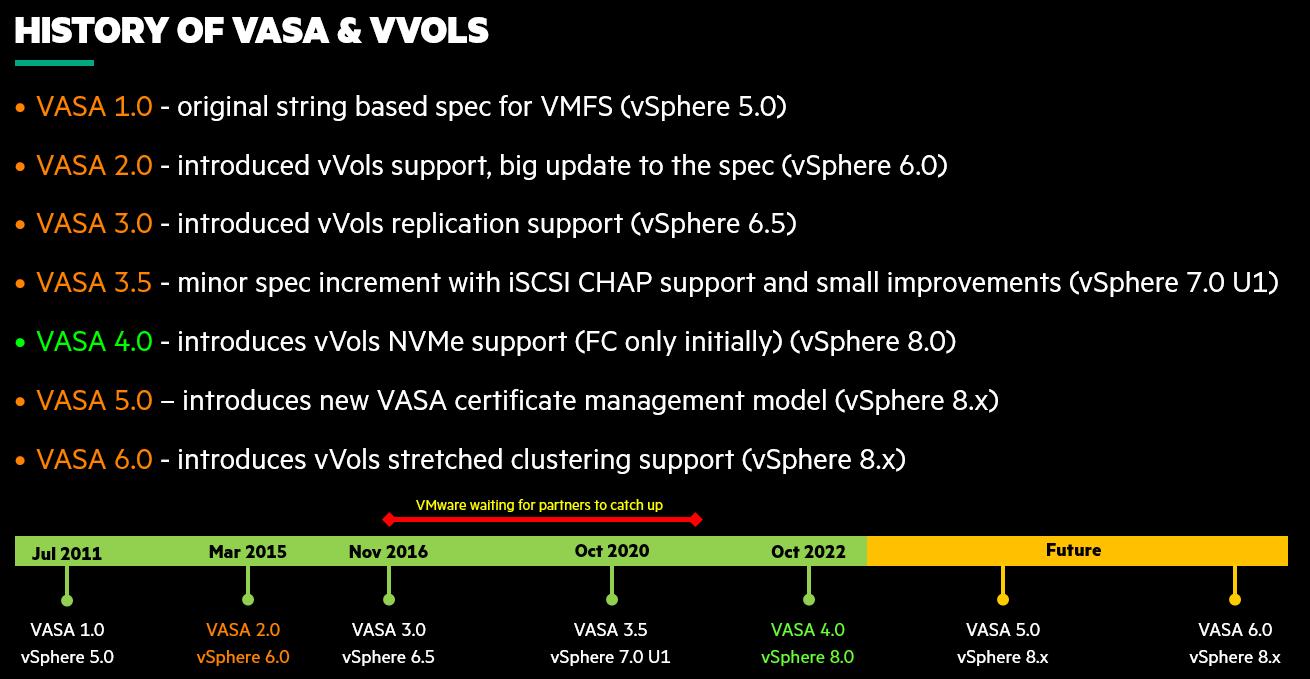
So we’ve come a long way with vVols and there is more good stuff coming soon. vVols is not what it was when it launched 7 years ago, it has become more mature, more robust and more capable than ever before. VMware is really putting in a lot of effort right now into vVols, their have been numerous small improvements under the covers with each release. I predict by next year we will see faster adoption of vVols and we will finally get to mainstream adoption.
It’s been a long journey with vVols and it has greatly evolved since those early days. I’ve been on that journey with VMware since the beginning and I look forward to seeing it through to the end.
Oct 08 2022
Why are so many VMware customers still on vSphere 6.5 & 6.7?
vSphere 6.5 and 6.7 is set to go end of support next week and vSphere 7.0 has been released for over 2 and a half years now while vSphere 8.0 is due out next week. Despite this a large percentage of the VMware customer base is still running 6.x versions even with them going end of support very soon. In this article I’ll take a look at some adoption stats and try to answer the question of why so many customers are still on vSphere 6.x.
First let’s look at the key timeline milestones for the major vSphere releases.
| Product release | General Availability | End of General Support | End of Technical Guidance |
| vSphere 7.0 | 2020-04-02 | 2025-04-02 | 2027-04-02 |
| vSphere 6.7 | 2018-04-17 | 2022-10-15 | 2023-11-15 |
| vSphere 6.5 | 2016-11-15 | 2022-10-15 | 2023-11-15 |
| vSphere 6.0 | 2015-03-12 | 2020-03-12 | 2022-03-12 |
| vSphere 5.5 | 2013-09-22 | 2018-09-19 | 2020-09-19 |
Now lets take a look at some version stats. We track the vSphere versions that customers use from the telemetry data of our storage arrays, VMware also tracks this as well via their vCenter analytics. Below is a look at that data from recent time periods to show what versions of vCenter and ESXi customers are running.
April 2022
| vCenter version | # | % |
| 6.7 | 4,487 | 46.2 |
| 7.0.3 | 3,131 | 32.3 |
| 7.0.2 | 910 | 9.4 |
| 6.5 | 843 | 8.7 |
| 7.0.1 | 133 | 1.4 |
| 6.0 | 106 | 1.1 |
| 5.5 | 54 | .6 |
| 7.0 | 46 | .5 |
| ESXi version | # | % |
| 6.7 | 33,225 | 47.9 |
| 7.0.3 | 12,702 | 18.3 |
| 6.5 | 11,555 | 16.7 |
| 7.0.2 | 6,811 | 9.8 |
| 7.0.1 | 2,724 | 3.9 |
| 6.0 | 1,910 | 2.8 |
| 5.5 | 364 | .6 |
| 7.0 | 168 | .3 |
From these numbers we can see that about 6 months ago 56% of customers were running vCenter 6.x and 67% are running ESXi 6.x bringing the majority of the VMware customer base on the older major release of vSphere. If we contrast this to today here’s what the numbers look like.
October 2022
| vCenter version | # | % |
| 7.0.3 | 5,578 | 50.5 |
| 6.7 | 3,781 | 34.2 |
| 6.5 | 724 | 6.6 |
| 7.0.2 | 691 | 6.3 |
| 7.0.1 | 112 | 1.0 |
| 6.0 | 84 | .8 |
| 5.5 | 44 | .4 |
| 7.0 | 40 | .4 |
| ESXi version | # | % |
| 7.0.3 | 28,717 | 37.7 |
| 6.7 | 28,223 | 37.0 |
| 6.5 | 9,925 | 13.0 |
| 7.0.2 | 5,462 | 7.2 |
| 7.0.1 | 1,850 | 2.4 |
| 6.0 | 1,532 | 2.0 |
| 5.5 | 365 | .5 |
| 7.0 | 185 | .2 |
We can see as of today that 41% of customers are running vCenter 6.x and 52% are running ESXi 6.x. So customers are finally starting to get off 6.x as it nears it’s end of support date next week. But there is still a very large percent using 6.x, especially on the host side.
I’ve always wondered why customers sit on those older versions so long instead of upgrading and gaining the new features and benefits that newer releases offer. Here are a few reasons I can think of why they stay on older releases.
- If it’s not broke, don’t fix it. Hey if it works, meets your requirements and you don’t care about new features then why upgrade which always carries a risk of something not working after the upgrade or issues while doing the upgrade. You also run the risk of compatibility issues as well.
- It takes time to upgrade. Larger enterprises with hundreds/thousands of hosts can take a very long time to do upgrades and the process can move very slowly to plan it out and get it done.
- Older hardware doesn’t always support newer software. Often times vendors will not qualify and certify newer versions of their software on older hardware platforms as they don’t have resources to test that many versions.
- Issues with licensing. I’ve heard in the past some applications like Oracle are more licensing friendly on older vSphere versions due CPU socket limits. Also upgrading typically means you have to invest in more licensing costs.
- Compatibility issues with apps and hardware. Sometimes certain applications or hardware is not cross compatible with newer versions of vSphere. In some cases it can take a while to achieve application cross compatibility nirvana across all your software and hardware as you wait for vendors to support newer versions. Also sometimes customers might be fearful that something may not work properly on newer versions.
- Refresh cycles can be along time coming. Some customers only do hardware refreshes every 5+ years and they typically wait to upgrade to newer vSphere versions until then. It can be a lot easier to stand up a whole new hardware environment running the latest versions of vSphere and then slowly migrate your VMs to it. Performing upgrades in place can carry some risk that customers may want to avoid.
- Nobody wants to deal with bugs. Newer software inherently carries the risk of being buggy until it has been thoroughly tested by the install base over a long period of time. As software products get more and more complicated the risks can increase and some customers want to play it safe and wait until it has matured before diving in.
So which version will most customers eventually migrate to? From the looks of it 7.0 U3 is where most customers are heading as it’s the latest and most stable release. With vSphere 8.0 releasing next week it’s doubtful that customers will move to that release in mass as historically most customers avoid new major releases until they mature and updates are released. With the past trends we have seen with vSphere 5.x & 6.x it will most likely be years before vSphere 8.0 becomes the majority release.
So if you’re one of those customers on vSphere 6.x or were very slow to migrate to vSphere 7.0 I’d be interested to hear your reasons for staying on the older versions so long. I’m sure there are other reasons that I have not covered here, so leave a comment and let me know.
Sep 08 2022
vVols 2022 Adoption Update: Current barriers and will it ever go mainstream?
It has been over 7 years now since VMware Virtual Volumes (vVols) was released as part of vSphere 6.0 but adoption remains extremely low to this day. I’m going to cover the reasons for that, where vVols stands today, what the future looks like and what needs to be done to more rapidly increase adoption.
First let’s talk about the technology “Crossing the Chasm” which visualizes the customer journey of adopting new technology. With new technology you typically have a small group of innovators and early adopters that like pushing the envelope and trying new things right away. You then have a “chasm” that you must cross before more customers trust that the technology is worth adopting often looking towards other customers to see if they are using it yet. This chasm is the make or brake point for a product going mainstream and being successful.
Pure Storage did a recent Tech Field Day and used the Chasm metaphor to show where they see adoption is today. I frankly don’t agree with their assessment and the numbers back me up. They claim we are in the early/late majority stage right now which simply isn’t true. I have tracked it across several of our storage platforms since the very beginning and I can tell you it’s still in the range of about 5 percent of arrays are configured to use it. The VMware telemetry data across their customer base on vVols adoption backs this up.
If you look at the Pure illustration of the Chasm below they break it down into Gen1 and Gen2 vVols with Gen1 being the early market of Innovators and Early Adopters and Gen 2 being mainstream majority market.

The current adoption numbers simply don’t back this up though, we’re still very much in early adopters stage with less than 10% of arrays using vVols. I would argue that Gen 1 of vVols was the Innovators stage, Gen 2 of vVols is the Visionaries stage which we are currently in and Gen 3 would be the stage when vVols finally crosses the chasm.
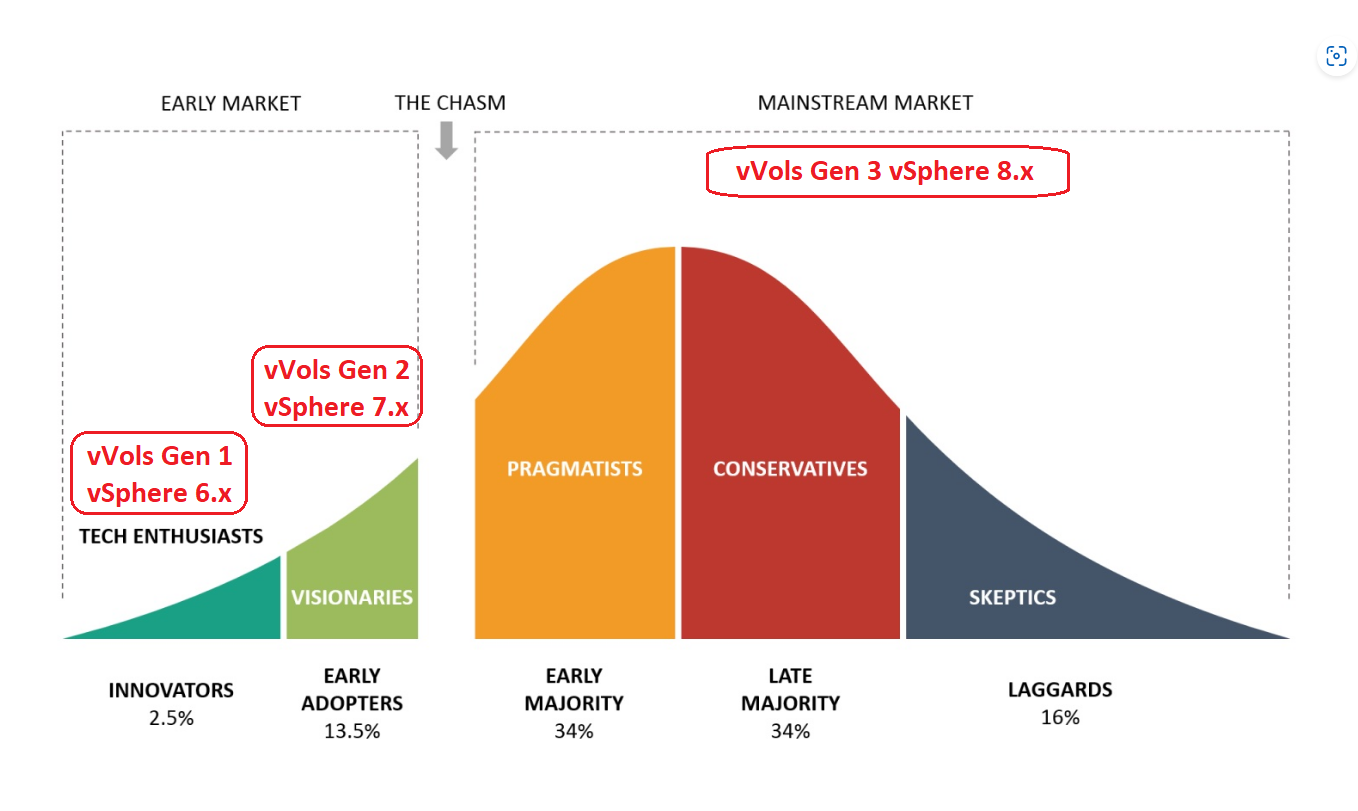
After 7 years you would expect a feature or product to see mainstream adoption, so why isn’t vVols there yet? I presented a list to VMware a while back of what I felt were the barriers compared to VMFS and what needs to be done to overcome them.

Some of the above list is being taken care of, there is a new certificate mechanism coming in VASA 5.0 that should make it easier to manage but you will still have to deal with certificates. Stretched clustering is in the works as well as part of VASA 6.0, it’s still fairly far out though. As far as it being completely done and on par with VMFS the upcoming VASA 4/5/6 should take care of most of that but there are still a number of challenges that VMware and partners must tackle before it can approach mainstream.
One additional area that is not on my list is with backup and recovery. Not all backup vendors have full support for vVols and have limitations and restrictions. I feel VMware needs to work with backup vendors as well to get them to fully support vVols. Additionally VMware needs to treat vVols as prime time and a first class citizen when it comes to any support and new features. Historically things typically come first to VMFS and later on to NFS and vVols.
As far as driving faster adoption, I’ve told VMware over and over until they announce they are deprecating VMFS people are going to sit on it forever. Historically this has proven true, customers sat on their ESX Service Consoles until VMware forced them to give them up and switch to ESXi. I don’t feel that VMware will ever deprecate VMFS though so this is going to require other ways to motivate customers to move to vVols which will be challenging.
One solution to this is for partners and VMware to work together to gently force people to start using vVols. Dell/EMC has done a good job with this on their PowerStore platform by pre-configuring vVols on their arrays and documenting that it’s a best practice to use vVols for an optimal experience. I know on HPE with the new HCI Manager UI for dHCI we also only allow VM’s to be created on vVols datastores. VMware could do their part by prioritizing vVols in their client UI’s and documentation to encourage customers to use vVols over VMFS.
Another thing I have told VMware what they really need to do to get adoption going faster is to relaunch and/or re-brand vVols to reintroduce it to customers. vVols was launched to much fanfare over 7 years ago and I was heavily involved in that launch planning all sorts of deliverables jointly with VMware to market it. However back then nobody was ready for vVols, it had many limitations, it wasn’t close to being done so all that effort was really wasted. Customers that did try vVols back then often had a bad experience with it and have no desire to repeat that.
Now vVols has come a long way in 7 years from a product development perspective but until the major programs (VASA 4/5/6) that are currently being developed that add some major functionality to vVols are complete it’s still not the right time to re-launch vVols. Once VASA 6.0 goes GA it will be the perfect opportunity to re-launch it and re-introduce it to customers. I strongly feel that they should re-brand it as well, this is commonly done to distinguish an old product that customers may have had a bad experience with to a newly revamped product.
vVols will get mainstream at some point, the benefits are well defined and VMware has put a lot of recent development effort into improving vVols. It’s on partners as well to speed up and prioritize their development of vVols so they make for a compelling solution across all storage platforms. There are partners that have great vVols solutions today but there are others that have lagged behind. One reason for this is when a product has low adoption it becomes difficult to make the case to prioritize engineering resources to it.
Despite the low adoption to date, vVols has a bright future ahead of it and as someone who has been there from the very beginning I look forward to the day we get there and the majority of customers are using a storage model that is better aligned with today’s much different use cases than when VMFS first launched over 20 years ago.
Oct 21 2021
My thoughts and observations on VMworld 2021
Another VMworld here and gone, blink and you might have missed it with it being a all virtual event again this year. I previously wrote that I wasn’t excited at all for this event based on my experience from last year. I did have higher expectations for this event compared to last year as this time around VMware has had a whole year to prepare for it and some experience from last years event. However overall it seemed to me even more disappointing an event compared to last year and it seemed like VMware put the bare minimum in to execute it perhaps based on they felt they won’t have to do this again after this year as they transition back to physical events.
Overall the event felt like giant webinar and not like an organized event. Their was nothing really to guide you through the event, their was a main page with some links and that was about it. The general session keynote felt like a big low energy infomercial, nothing like the exciting keynotes of past events. The breakout sessions were a mix of on-demand and live Zoom calls, they were OK but again you didn’t feel like you were part of the session at all. The Solutions Exchange was largely worthless, I know you can’t replicate an on-site event but they could of done much more to make it a better experience for both vendors and attendees.
Thankfully this will be the last year as a virtual event, according to VMware next years event will be largely on-site. Here’s their official statement on that:
[important]We are making plans to return to an in-person event in San Francisco, August 30 – September 1, 2022 and Barcelona, November 7-10, 2022. We are currently evaluating opportunities for a hybrid model, offering some elements of content in a virtual form, but expect the major program components and opportunities for sponsors and exhibitors to be in an in-person format. We will share more information as it becomes available.[/important]
I can’t wait until things are back to normal as I really miss the whole VMworld experience which was like the Super Bowl for VMware geeks. For next years event it will have been 3 years since I have seen old friends and I’m hoping next years event will be a special one for all of us.
Sep 23 2021
VMworld is almost here and frankly I’m not really excited
It’s that time of year again, albeit a little later than normal, time for VMware’s marquee event, VMworld. I’ve been attending VMworld since 2008 and with the event again virtual this year I’m just not feeling any excitement about it. I wrote about my experience with last year’s virtual event (spoiler alert: I hated it) and it looks like not much is changing this year to make the experience any different. I cut VMware some slack last year as they did not have a lot of time to make the transition to a virtual event but this year they have had a full year to prepare for it. Perhaps they don’t want to invest to heavily in the platform and experience for a virtual event if they anticipate this will be the last year they need it.
To me this event just feels like a big webinar, it’s almost impossible to reproduce the physical event experience in a virtual event but I feel VMware could do more to try and replicate that experience as much as possible. The biggest advantage of a physical event is networking, in a virtual event that is much more difficult to arrange in a way that you feel like you are having meaningful and personal conversations with others. I haven’t spoken to old friends in years now, an experience I sorely miss.
Then you have the virtual solutions exchange, I’m sorry but those virtual booths simply suck. The solutions exchange was the standout feature at the physical event, walking around seeing what each vendor has to offer and the cool booth setups, running into friends, getting hands on with demos and talking to product experts. There is no way to reproduce that experience in a virtual event.
Of course the night life was always fun as well and that is another experience that you can’t replicate. Watching a band over Zoom feels like watching a band on YouTube, it’s just not the same as being there. Those late night hanging with friends was always a highlight for me and that is something you can only do in person.
So I registered again this year, albeit it very late as I really didn’t feel that rush to register like you would for a physical event. I scheduled some sessions, again since they are largely like a webinar I felt no sense of urgency to schedule them. My backpack collection just collects dust and there have been no new additions to it now for 2 years. My wall full of hanging event lanyards hasn’t gotten any bigger in 2 years as well.
I’ll watch the general session, some technical sessions and participate in the vExpert activities. Corey Romero to his credit has gone above and beyond to try and make the vExpert activities as fun and social as possible. But beyond that VMworld will pass quickly by with no new notable memories or experiences and to me it’s like it never even happened as a virtual event just isn’t the same as being there in person. So hopefully next year things can open up again and we can back to in person events which I am sure everyone misses so we can feel like we actually attended something and cherish all of the benefits that a physical event brings.
Stay safe my friends and I hope to see you in person again soon…
Oct 12 2020
My thoughts and observations on VMworld 2020
Another VMworld has passed, this year it was a month later than usual and also completely virtual. The week before VMworld I wrote about how it didn’t feel like VMworld at all and seemed to be lacking all the excitement that usually leads up to the event. Having now experienced this virtual VMworld I can report that I was fairly disappointed and it felt more like an extended webinar than an actual event. Lets go into the details in my usual format.
The Location
Usually you have the whole SF vs Las Vegas debate with some liking one location over another. This year that didn’t matter as it was virtual so lets focus on the platform they used to deliver VMworld. Overall I thought the “design” or whatever platform they used was very bland and seemed more like I was browsing a website instead of attending a virtual event. The whole event was just a series of web pages not very well connected together and left the attendee confused on where to start and how to navigate the event. The main page shown below just had some links to other pages for specific content.
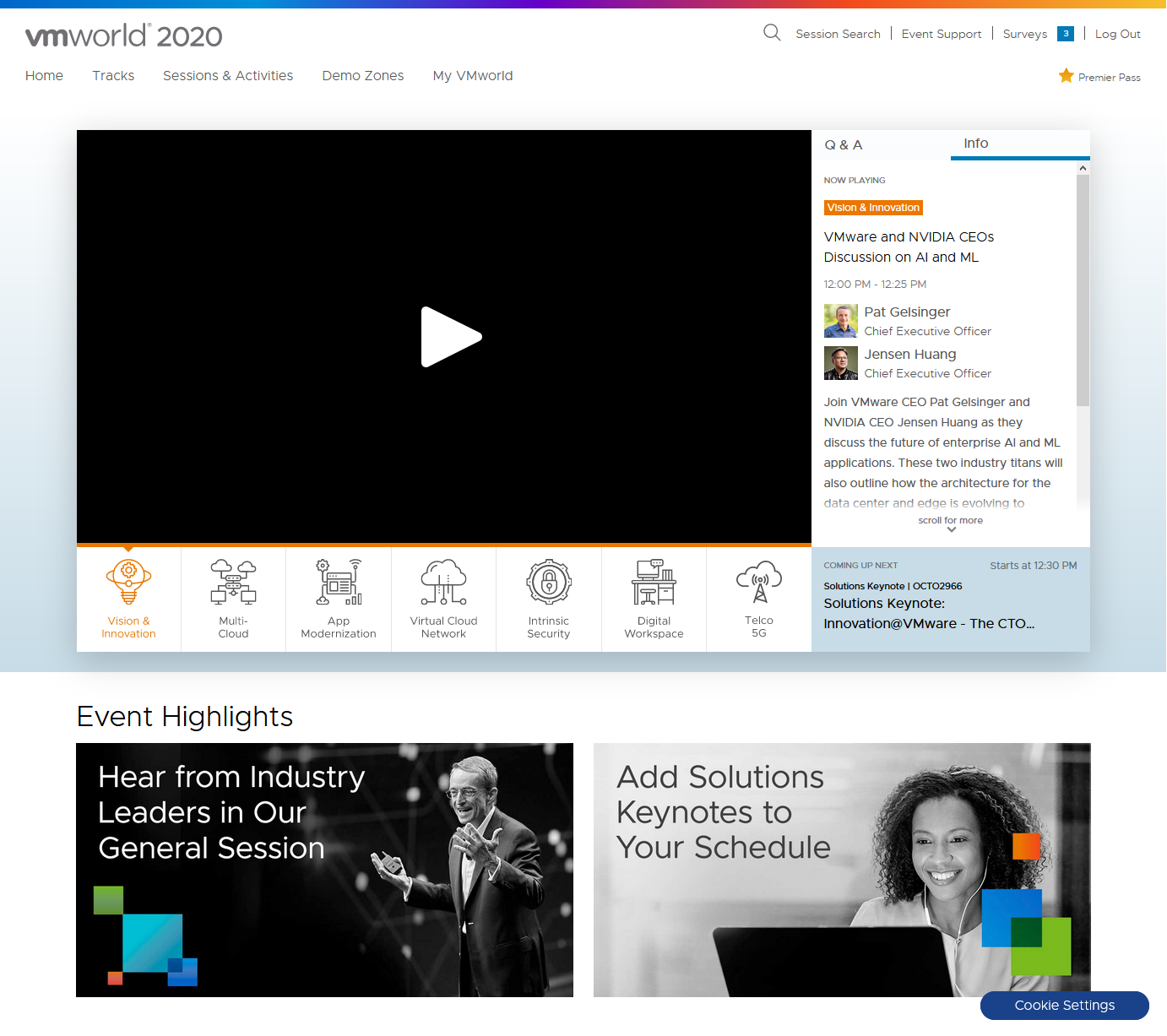
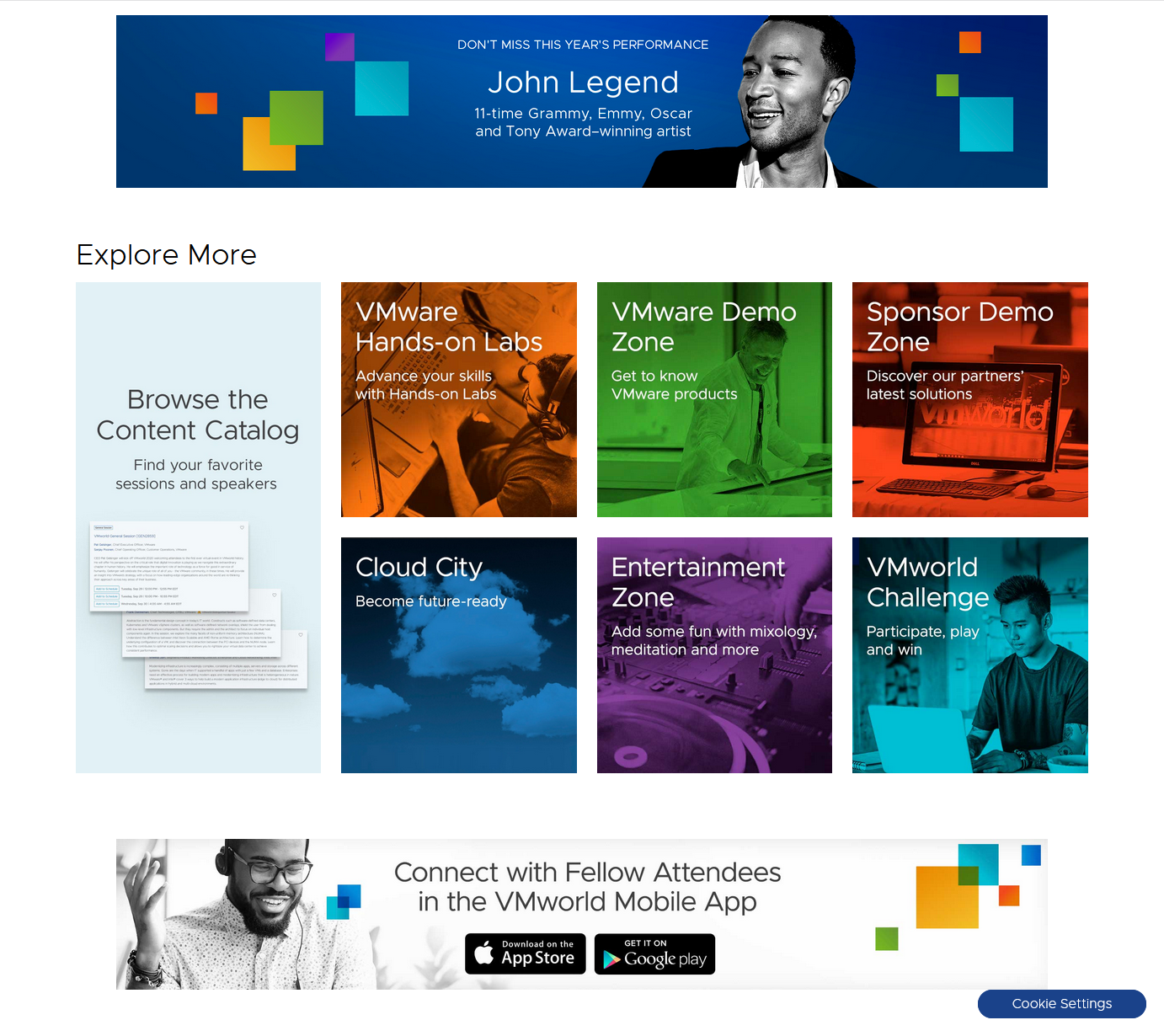 This didn’t have an event feel at all to it, in contrast if you are familiar with virtual VMUGs they structure the event web page to look like an actual event using the vFairs platform as shown below.
This didn’t have an event feel at all to it, in contrast if you are familiar with virtual VMUGs they structure the event web page to look like an actual event using the vFairs platform as shown below.
 With the virtual VMUG events you felt more like you were attending an event with the same familiar layout that you expect at events and you distinctly knew how to navigate and find different areas. With VMworld this year I had no clue where to start and find various content, eventually I figured it out but it felt very dis-connected and un-welcoming.
With the virtual VMUG events you felt more like you were attending an event with the same familiar layout that you expect at events and you distinctly knew how to navigate and find different areas. With VMworld this year I had no clue where to start and find various content, eventually I figured it out but it felt very dis-connected and un-welcoming.
One big thing which is the reason many attend these events is the networking with other people and meeting up with old friends. That’s an experience that is almost impossible to duplicate virtually but I thought VMware could make a decent effort at it given the large number of social networks that exist today. Sadly they didn’t, if you look at the main webpage it says “Connect with fellow attendees with the mobile app”. I didn’t even bother downloading the mobile app as that is something I would only use if I was actually attending the physical event to help me stay organized with my schedule and look at maps to find where to go. Sitting at home attending the event on my PC I don’t want to have to use a mobile app, a PC provides a much better experience, I’m guessing the majority of the people attending VMworld used a PC instead of a mobile device. As VMworld provided no mechanism to socialize with other attendees on the event website their was no way for many thousands of users to connect with each other from their homes on their PC.
Overall it felt like VMware didn’t put much effort into the platform for the event. I understand they did not have a huge amount of time to invest as it was probably around April when it was decided they need a plan B and even with the event being in Sept this year they only had 5 months to execute that plan. But I would wager to say there are better platforms for virtual events and you would think a technology and cloud company would have an edge on developing a decent platform for the event. I’m guessing maybe they purposely didn’t put in too much effort as they anticipate this is a one off thing and they won’t have to do a virtual event ever again.
How many people attended VMworld?
This year the event was free for everyone to attend so you would expect attendance to be way higher than the usual 20-25k attendees. I know from internal reports as a sponsor that they were 54,000+ companies registered a week before the event. I heard that there were over 150,000 people that signed up for the event which is a significantly larger audience than they have had at physical events. This is great as it gives more people exposure to all the sessions and goof for sponsors as they have a larger audience to interact with. It would sure be nice if VMware considered offering a virtual option and a physical option to attend the event going forward.
What was announced at VMworld?
As expected VMware’s focus at VMworld was largely on containers and clouds and the announcements centered around that.
vSphere 7.0 Update 1 was announced before the event and is now generally available. The big ticket item is that the native Kubernetes integration that was introduced in vSphere 7.0 is now generally available in vSphere without requiring VC. This enables BYO networking (vDS), NSX is no longer required, it also enables BYO storage – vSAN & vVols provide the best solution (SPBM) but you can also use traditional VMFS/NFS storage and BYO load balancer (HAProxy). In addition a new feature called vCenter Connect allows you to manage vCenter running on any cloud platforms from a single interface. VMware also increased cluster scale from 64 hosts to 96 hosts and also enable a truly monster VM with up to 768 vCPU and 24TB vRAM. This was achieved by tuning ESXi scheduler and co-scheduling logic for large VMs, removing bottlenecks in vCPU sleep/wakeup paths and reducing memory overhead .
 VCF 4.1 was also announced before the event and included a new feature called vSAN Data Persistence aimed at supporting containers and also support for remote clusters to extend VCF to edge and remote locations while still be centrally managed. However the big thing in VCF 4.1 is vVols now supported as Principal Storage in VCF Workload Domains. This also adds support for iSCSI storage (but only for vVols) as up until now only FC was supported. VCF does support traditional VMFS/NFS but it is not optimal as it only supports tag based capabilities (VASA 1.0) and not the full SPBM management (VASA 2.0/3.0).
VCF 4.1 was also announced before the event and included a new feature called vSAN Data Persistence aimed at supporting containers and also support for remote clusters to extend VCF to edge and remote locations while still be centrally managed. However the big thing in VCF 4.1 is vVols now supported as Principal Storage in VCF Workload Domains. This also adds support for iSCSI storage (but only for vVols) as up until now only FC was supported. VCF does support traditional VMFS/NFS but it is not optimal as it only supports tag based capabilities (VASA 1.0) and not the full SPBM management (VASA 2.0/3.0).
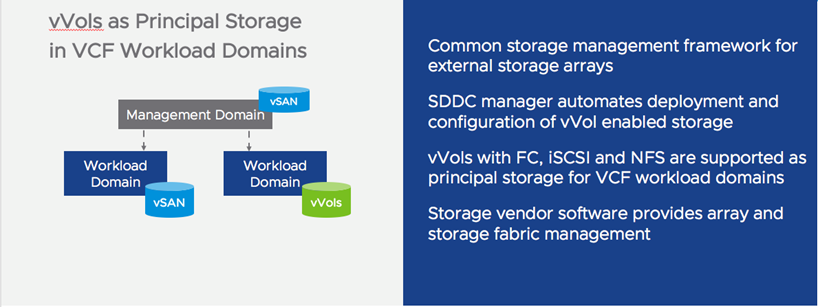 Probably the biggest announce was the introduction of Project Monterey, last year they announced Project Pacific which was focused on native Kubernetes integration which is already GA, this year it’s Project Monterey which is focused on using new hardware capabilities to enhance VCF. Project Monterey is a redesign of VCF to take advantage of these new disruptive hardware capabilities by moving functionality that used to run on the core CPU complex to the SmartNIC CPU complex. What is a SmartNIC you say? A SmartNIC is a beefed up NIC with a general-purpose CPU, out-of-band management, and virtualized device functionality that provides acceleration and offload functions minimizing CPU interruption to support I/O functions (accelerated network and storage operations run in parallel with CPU processing).
Probably the biggest announce was the introduction of Project Monterey, last year they announced Project Pacific which was focused on native Kubernetes integration which is already GA, this year it’s Project Monterey which is focused on using new hardware capabilities to enhance VCF. Project Monterey is a redesign of VCF to take advantage of these new disruptive hardware capabilities by moving functionality that used to run on the core CPU complex to the SmartNIC CPU complex. What is a SmartNIC you say? A SmartNIC is a beefed up NIC with a general-purpose CPU, out-of-band management, and virtualized device functionality that provides acceleration and offload functions minimizing CPU interruption to support I/O functions (accelerated network and storage operations run in parallel with CPU processing).
So basically it’s like having a second mini server in your host, however what’s unique about it is that it is an ARM based processor so ESXi had to be adapted to run on ARM (we’ve seen demos of that the last couple VMworlds). So it enables you to run a second instance of ESXi on the SmartNIC which can be managed separately or as a single logical instance. It also has bare metal support as well so you could potentially run Windows or Linux on it. Some use cases for this are offloading network and security functions to free up more CPU cycles on the host and better handle network intensive workloads. It can also accelerate storage function such as encryption, compression and erasure coding (vSAN use case) and also offering bare metal as a service with vSphere.
To enable this VMware is partnering with DPU vendors Pensando, Intel (Mellanox BlueField-2) and Nvidia and server partners HPE, Dell and Lenovo. If you want to learn more about this check out blog post and also this session HCP3004 with Kit Colbert, note this is a tech preview so don’t expect to see it for a while.
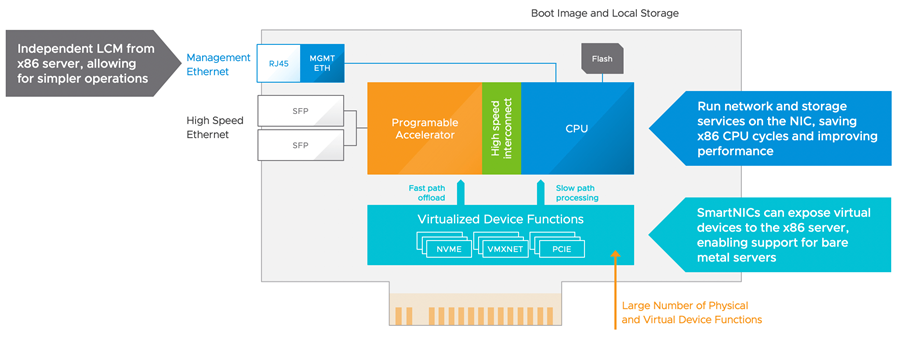 VMware also announced a new Tanzu edition that provides Kubernetes support on VMware Cloud on AWS. Tanzu Basic is Kubenetes in vSphere (without VCF) and Tanzu Standard is VMware’s hosted version of it. There are 2 more Tanzu editions coming out later which presumable will provide more functionality.
VMware also announced a new Tanzu edition that provides Kubernetes support on VMware Cloud on AWS. Tanzu Basic is Kubenetes in vSphere (without VCF) and Tanzu Standard is VMware’s hosted version of it. There are 2 more Tanzu editions coming out later which presumable will provide more functionality.
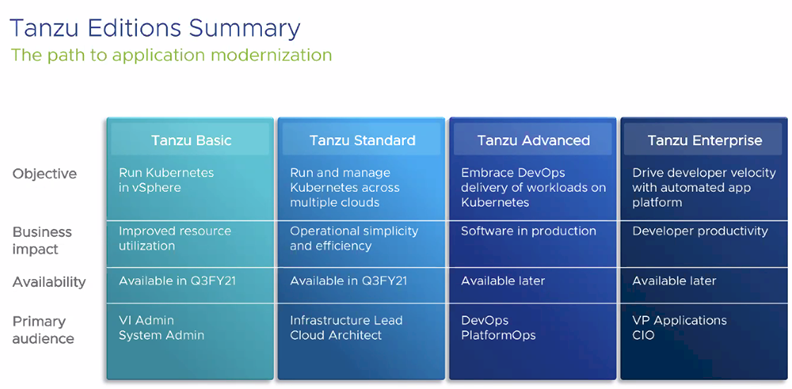 The rest of the announcements focused on the vRealize product family. Project Magna which VMware announced last year is now GA and renamed vRealize AI Cloud. It’s basically an add-on to vROPs that provides a self-optimizing service that uses machine learning and a big data lake to continually monitor performance and learn and optimize your storage KPIs. Right now it’s only focused on vSAN but I’m guessing VMware will extend this support to any storage. Note this new functionality is only available as a cloud based service which brings me to the next announcement.
The rest of the announcements focused on the vRealize product family. Project Magna which VMware announced last year is now GA and renamed vRealize AI Cloud. It’s basically an add-on to vROPs that provides a self-optimizing service that uses machine learning and a big data lake to continually monitor performance and learn and optimize your storage KPIs. Right now it’s only focused on vSAN but I’m guessing VMware will extend this support to any storage. Note this new functionality is only available as a cloud based service which brings me to the next announcement.
 VMware also announced new vRealize licensing and a new vRealize Cloud Universal offering. Over the last few years VMware has worked to ensure that their vRealize Cloud based offering (SaaS) uses the exact same code base as the on premise vRealize software. So you can either have VMware manage your vRealize software for you in the cloud (to manage your on-prem environment) or just deploy vRealize on your own in your private data center. What vRealize Cloud Universal does is provide a combined offering of SaaS and on-premises giving customers the ability to choose their deployment options so you can run it in either place and go back and forth if you want. Note yo only get access to the AI Cloud option if you deploy it as SaaS.
VMware also announced new vRealize licensing and a new vRealize Cloud Universal offering. Over the last few years VMware has worked to ensure that their vRealize Cloud based offering (SaaS) uses the exact same code base as the on premise vRealize software. So you can either have VMware manage your vRealize software for you in the cloud (to manage your on-prem environment) or just deploy vRealize on your own in your private data center. What vRealize Cloud Universal does is provide a combined offering of SaaS and on-premises giving customers the ability to choose their deployment options so you can run it in either place and go back and forth if you want. Note yo only get access to the AI Cloud option if you deploy it as SaaS.
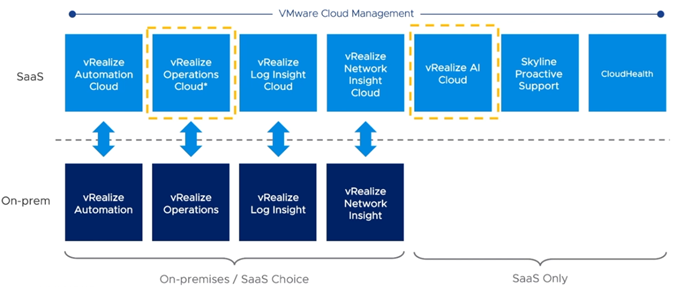 Finally VMware also announced plans to acquire SaltStack which is a is Python-based, open-source software similar to Ansible that provides event-driven IT automation, remote task execution and configuration management. VMware plans to integration this into vRealize Automation specifically for cloud management but they also claim they will preserve the open-source Salt ecosystem.
Finally VMware also announced plans to acquire SaltStack which is a is Python-based, open-source software similar to Ansible that provides event-driven IT automation, remote task execution and configuration management. VMware plans to integration this into vRealize Automation specifically for cloud management but they also claim they will preserve the open-source Salt ecosystem.
How were the General Sessions?
At VMworld I’m used to exciting general sessions with cool announcements and product demos. If you came to see that this year you would have been sorely disappointed. Instead of 2 general sessions there was only 1 and it was only 1 hour in length. The general session was pre-recorded with Pat and Sanjay and basically consisted of some high level strategy reinforcement and customer interviews. I didn’t find it interesting at all, it felt like a marketing webinar. I think if VMware tried to make it look like an actual live keynote, having speakers on a live stage it would have at least gave the perception of being an actual event instead of basically a pre-recorded webinar.
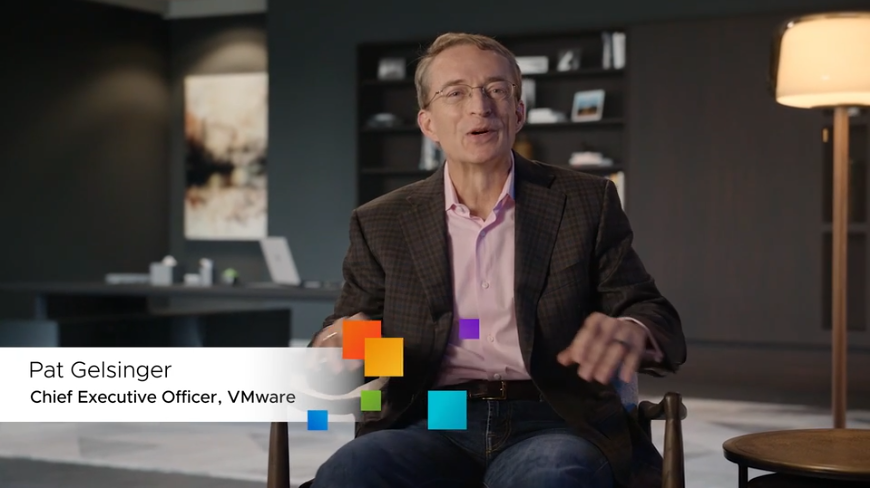 How were the Breakout Sessions?
How were the Breakout Sessions?
VMware did a great job with this, most of them were pre-recorded but VMware had pretty rigid recording requirements to make them look as professional as possible. Because this was a virtual event they were able to accommodate more sessions than usual and there are a total of 714 breakout sessions currently listed in the Content Catalog with 557 of them being technical level sessions. All of the sessions were immediately available right after the keynote on Tuesday for anyone who registered for free to view. This was the real value prop of VMworld this year, more sessions available right away and open to everyone. If you haven’t watched any sessions yet go head over to the Content Catalog and dive in.
There was also an optional Premier pass that you could purchase for $299 that provided access to live expert roundtable and birds-of-a-feather sessions. I purchased the Premier pass and attended a few roundtable sessions, you were limited to being able to schedule only 3 of them. The roundtables were done with Zoom and limited to about 40 people and moderated by a SME from VMware. The VMware speaker would usually start off with a few slides introducing the topic and then it was up to attendees to ask questions. I generally found that most people on the call were there to listen so it was hard to solicit questions which made the session less interesting. The roundtables were also not recorded so there was no way to watch them after they were over.
What was going on in the Solutions Exchange?
So obviously since this was a virtual event there was a virtual Solutions Exchange (aka Sponsor Demo Zone). Where this is usually one of the best parts of the event as it allows for a lot of live interaction with vendors and attendees with the virtual event I felt this was the weakest part of the event. Vendor booths if you even want to call them that were basically an info webpage with a rigid structure to it, you get post a few videos (5 min max), have up to 10 links and it would show the sponsored sessions and speakers for them. All the vendors had a link box in the sponsor demo zone page that were displayed ranked by sponsorship level. This really limited what a vendor could do and show within their booth, you certainly did not have the ability to do traditional demos in your booth.
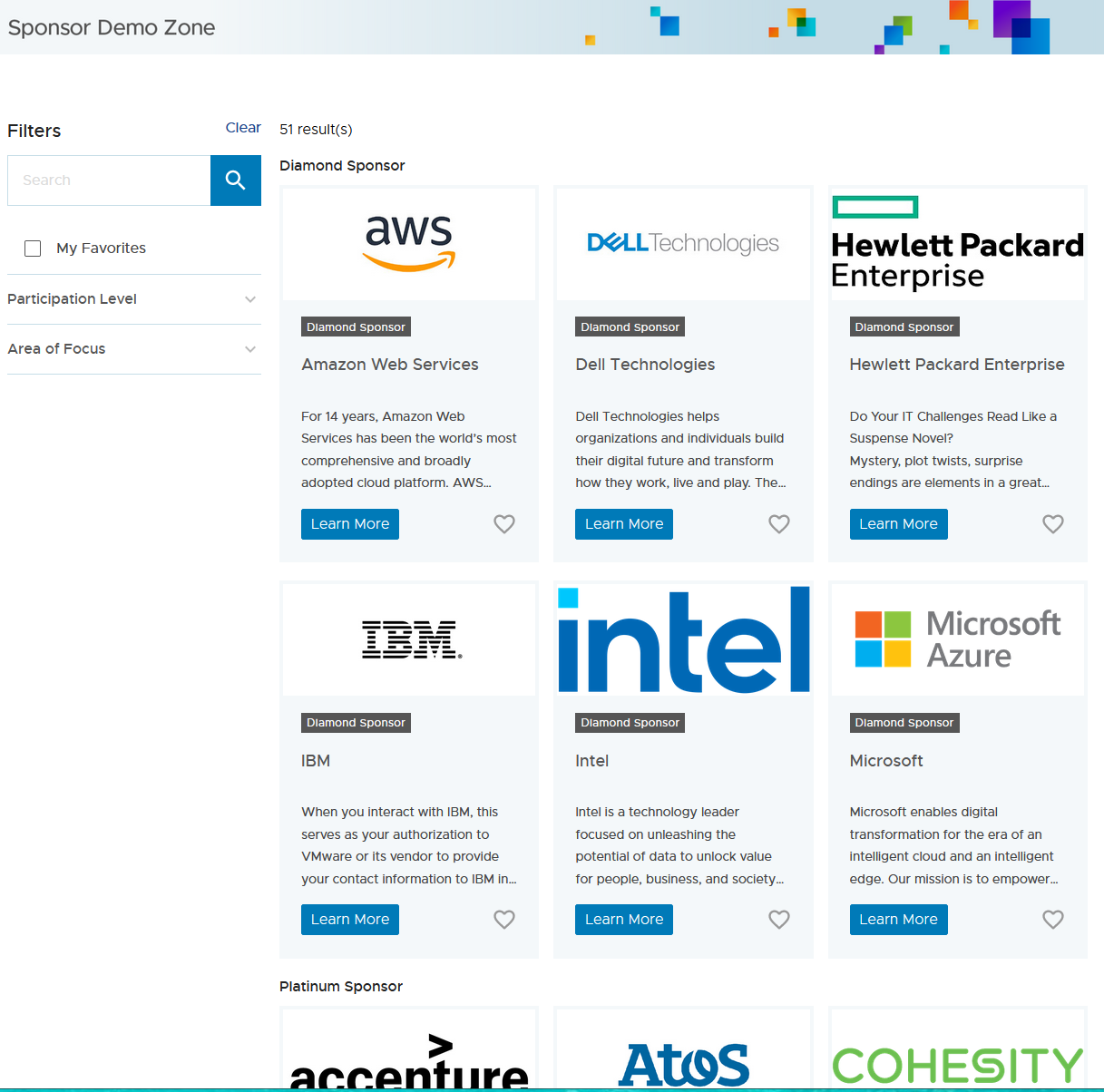
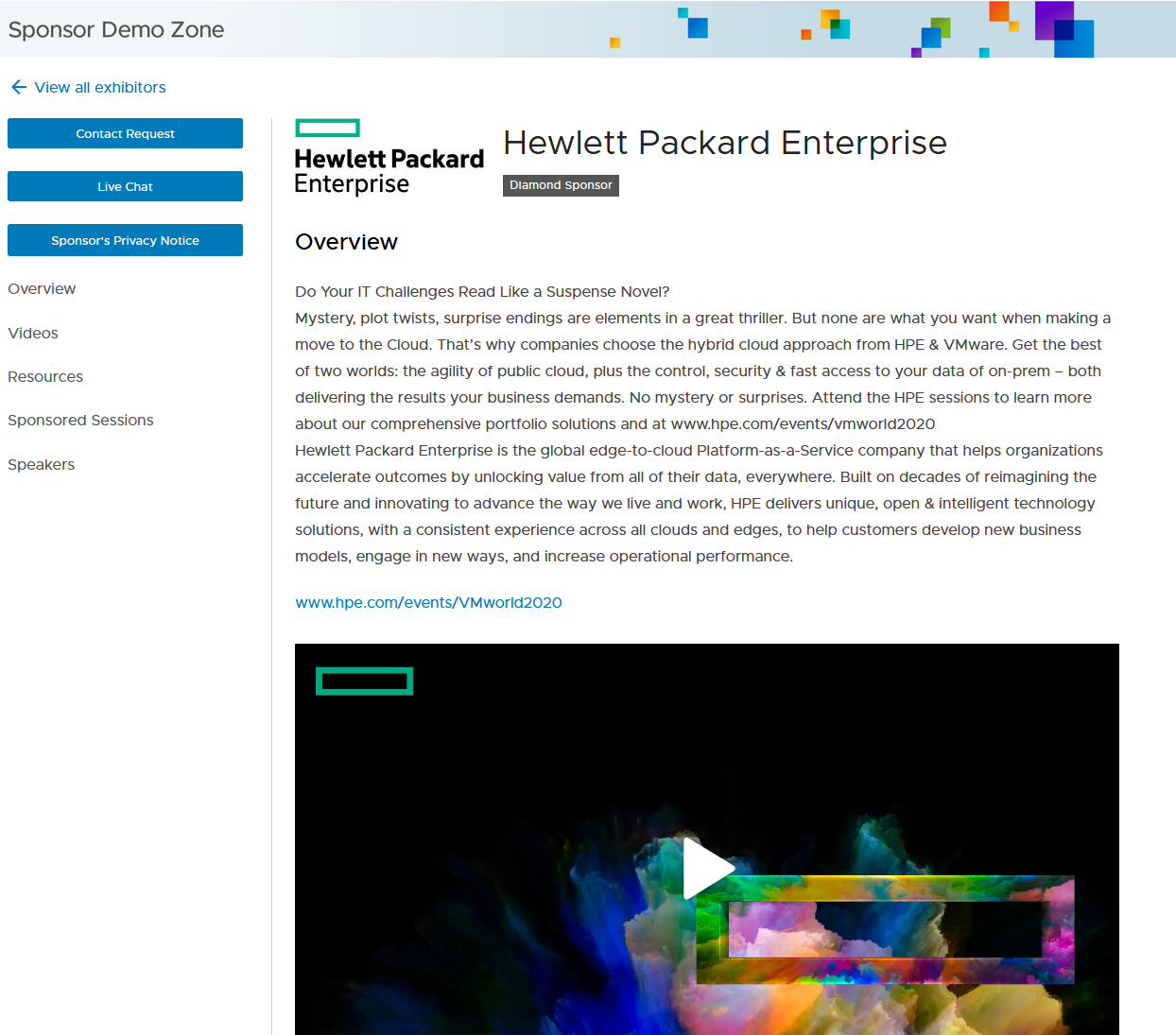
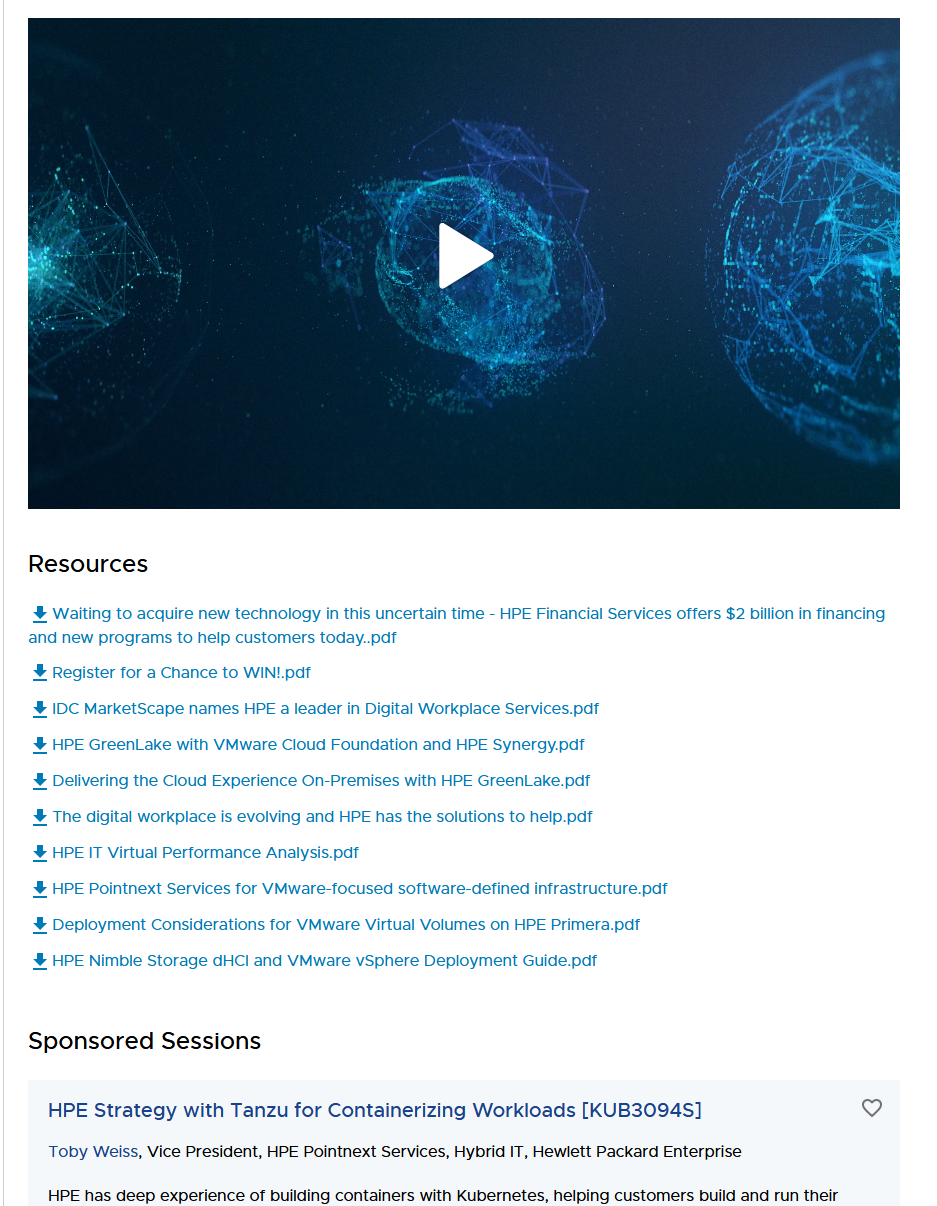 There was a really basic live chat function available within the booth and I stress basic. It had a very basic UI and was a 1:1 chat with whoever is staffing the booth. I prefer the way VMUG implemented booth chat which was more of a group chat within the booth so you could see other attendees chatting with everyone staffing the booth. Overall I felt the booth experience was very lacking and did not encourage a good interactive experience between attendees and booth staff.
There was a really basic live chat function available within the booth and I stress basic. It had a very basic UI and was a 1:1 chat with whoever is staffing the booth. I prefer the way VMUG implemented booth chat which was more of a group chat within the booth so you could see other attendees chatting with everyone staffing the booth. Overall I felt the booth experience was very lacking and did not encourage a good interactive experience between attendees and booth staff.

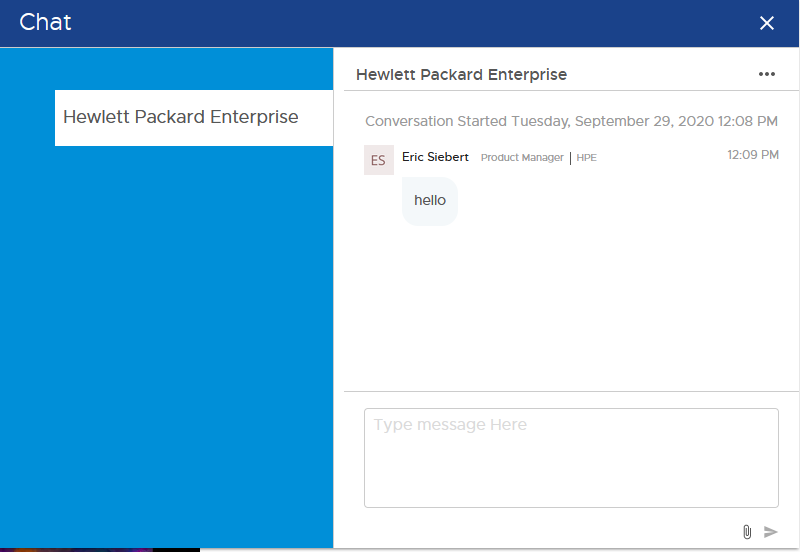 vExpert Activities
vExpert Activities
I didn’t look that hard but from what I saw that wasn’t really anything going on special for vExperts. Cohesity did a nice giveaway before VMworld, thank you very much for that, but other than that I don’t think there was anything else happening. The annual vExpert party did not occur this year.
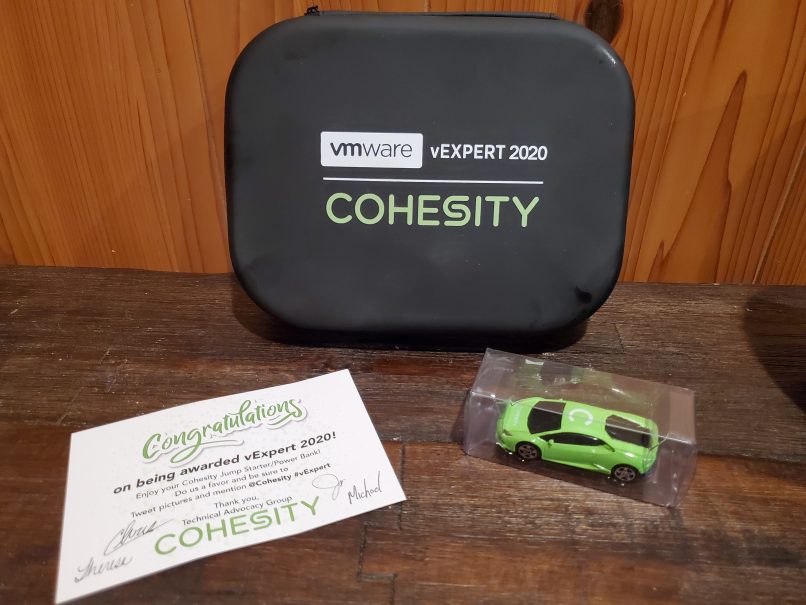 How about the parties?
How about the parties?
There are typically no shortage of epic parties and gatherings at VMworld, however that is really hard to do at a virtual event. VMware did make a decent effort to add some fun to the event, they had an Entertainment Zone that had some fun sessions with performers such as magicians, a painter and a comedy juggling team. I didn’t watch any of them and it probably wasn’t the same as seeing it in real-life but at least it provided a fun angle to the show. There was also a short 30 min performance from John Legend solo from his house on the piano.
 Final Thoughts
Final Thoughts
Overall I was fairly disappointed in the event, largely around the presentation and execution of it. There were some aspects that were better, the larger audience, the free attendance, more sessions available immediately but overall the value for me is in the networking, social interaction and the whole in person demo zone. It’s understandable that some of this suffered due to being a virtual event and not a huge amount of time to make the transition but I felt VMware could of done more to make it seem like an actual event with more of a social element and less like being a website with links.
So hopefully this year was a one off and we can get back to our regularly scheduled programming next year. I’m hoping a year from now this virus will be behind us enough to have an in person conference, but with the threat being only reduced and probably not entirely diminished until the end of next year I’m sure the event will be more scaled down next year if it is held in person. My backpack collection now has a year gap in it that will be a constant reminder of the hardships that 2020 has had on everyone and a reminder that at the end of the day what’s really important is everyone’s health and missing a physical conference is a small price to pay to ensure the greater good.
Sep 25 2020
VMworld is here! But it sure doesn’t feel like it…
It’s that time of year again, albeit a bit later than usual, it’s time for VMware’s annual mega conference, VMworld. For me this will be VMworld number 13 and with VMworld being virtual this year its going to be a way different experience. I could say I won’t miss the travel, the expensive hotel rooms in San Fran, the sore feet from all the walking, all the street noise and people to deal with but I actually think I will miss it. Maybe its from not traveling for over 6 months, maybe I just found that whole environment oddly comforting or maybe I just need to get out again. What I do know is I’ll miss seeing all the people, the whole solutions exchange atmosphere, making new friends, visiting with old friends, late nights socializing, my annual meet Pat Gelsinger at the vExpert party and of course the VMworld backpack (I have a whole closet full of them).
With VMworld starting in just a few days, I don’t feel any of the usual excitement that I usually feel leading up to the event and I feel pretty dis-connected from the event, almost if I got distracted for whatever reason I might miss it. I know VMware will be making it’s best effort to put on the best possible show but it just won’t be the same, not even close to it. The sessions are mostly pre-recorded and the solutions exchange is just virtual booths lacking real demos, real equipment, real people (and of course swag). The biggest missing element will be the networking and interaction with people, try as you might you just can’t replicate that in a virtual event.
I am speaking in 2 sessions this year, an SRM/vVols session along with Velina from VMware and Cody from Pure and then an HPE session where I have a brief part on vVols. Recording the sessions was a challenge, especially with multiple speakers and I’ll miss the waiting for the room to fill up to see how many will show, the audience interaction and the questions. VMware put a lot of effort into making sure the technical aspects (video/audio/etc) of the sessions are very good so I have no doubt it will be quality content. One benefit of being virtual is most of the sessions will be available right at the start and free for everyone so there will be a much bigger audience for the event. I heard from our planning team that 54,000+ companies have registered for the event so the audience will be much bigger. There is also paid content that is live such as expert sessions and roundtables that you can gain access to with a Premier Pass ($299).
So I’ll try and make the most of this years event, it will be hard to block out time for it and with all the other distractions from being in a home/work environment it might be difficult to focus solely on the event. I’m not sure where to even start or how to ensure that I’m getting at all the content available on those 2 days so I’ll have to figure that out. There is a lot of things I’ll miss this year and I’m really looking forward to going back to physical events. One thing I know I’ll really miss is sitting around with my good buddies Jason Boche and Bob Plankers smoking stogies late into the night. I’d normally conclude by saying I hope to see you there but that’s just not going to happen this year, so stay safe, try and make the most of the event and I hope to see you all sometime in the future.



